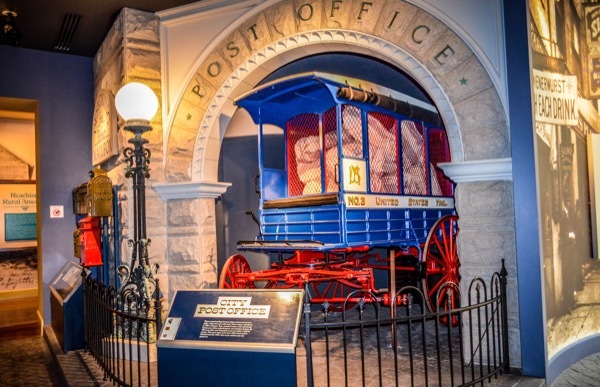If you’re at all interested in the romance and adventure of the story of U.S. mail correspondence and its delivery (that’s right, I said romance and adventure!), and in the international artistry and invention of that most miniature of art forms, the postage stamp, you really need to venture into this less-visited Smithsonian museum. You’ll find yourself in the elegant lobby of a historic structure designed by Daniel Burnham in 1914. The building operated as a post office until 1986; it was reborn in 1993 as the Postal Museum.
Head downstairs to tour the original part of the museum, where America’s postal history from 1673 to the present is on display. In the central exhibit area called Moving the Mail, you’ll see planes, trains, and other postal vehicles that have been used at one time or another to transport the mail. Kids delight in the sight of Owney the Dog, a replica of the scruffy pup that traveled with postal workers aboard Rail Mail Service trains in the late 19th century, becoming the unofficial mascot of the RMS.
In Binding the Nation, visitors can follow a path through a forest to trace the steps of mail carriers who traveled from New York to Boston in 1673, and climb into a stagecoach headed west. The exhibit introduces famous figures, like Buffalo Bill, of Pony Express renown; and founding father Benjamin Franklin in his role first as postmaster general for the British colonial post (until he was fired for his revolutionary activities) and then as postmaster general for the United Colonies.
Other exhibits cover mail’s impact on city streets and rural routes (Customers & Communities), the journey a single letter takes through the postal system and how that process has changed over time (Systems at Work), and the history and current practice of getting mail delivered to and from military personnel (Mail Call). Behind the Badge reveals the work of the U.S. Postal Inspection Service: Established in 1776, the federal agency is responsible for restoring mail service after disasters, spotting and preventing mail fraud, and keeping mail safe from the likes of Unabombers and lesser criminals.
Return upstairs to explore the William H. Gross Stamp Gallery ★★★, the world’s largest stamp gallery. On view are displayed treasures from the museum’s 6-million-piece National Stamp Collection, including its rarest U.S. acquisition, the 1868 1-cent z-grill stamp, one of only two known to be pressed into a grill pattern. Interactive kiosks, videos, and activities keep even the non-stamp-collector interested, enthralled even. The World of Stamps permanent exhibit features a hit list of famous stamps, starting with the very first postage stamp, the 1840 Penny Black, bearing the profile of a young Queen Victoria. Stamps Around the Globe displays international stamps, which make up more than half the Postal Museum’s overall collection (everything from a colorful 1965 Rwanda stamp displaying Cape buffalo to a delicate rose-tinted coat of arms on the 1859 stamp from the German state of Lübeck). Viewing these miniature artworks is a thrill.
Don’t miss the last gallery, the Postmasters Suite, housed in a gorgeous, six-sided paneled room. It’s reserved for special exhibits. Sports fans will love the exhibit “Baseball: America’s Home Run,” on view through January 2025 and featuring hundreds of U.S. and international stamps commemorating great players and historic moments.
Tip: The Postal Museum’s wall of windows features replicas of 54 historic U.S. stamps; come by at nighttime and you’ll see the artwork illuminated.






 About our rating system
About our rating system


